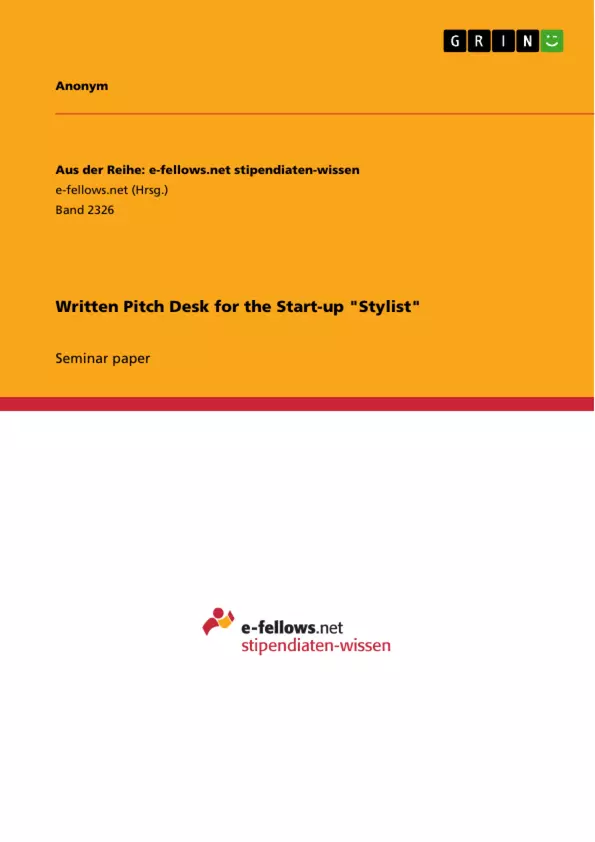This work is the written version of a ptich desk for the course Entrepreneurial project. Different tools like the scenario scratching, market analysis, SWOT analysis, lean start-up method, canvas map have been utilised to make this pitch desk.
Inhaltsverzeichnis (Table of Contents)
- THE PROBLEM
- ALTERNATIVE SOLUTIONS
- OUR SOLUTION
- BUSINESS VALUE AND ARCHITECTURE
- THE VALUE PROPOSITION
- TESTING THE MVP
- PERSONA CARDS
- MARKET EXISTING AND EVALUATION
- COMPETITIVE ADVANTAGES
- KEY COMPETENCIES AND THEIR RELATION TO THE SUCCESSFULNESS
- BUSINESS MODEL CANVAS
- MARKETING AND SALES
- FINANCIAL STRUCTURE
- CONCLUSION AND DEMAND
Zielsetzung und Themenschwerpunkte (Objectives and Key Themes)
The primary objective of the work is to present a comprehensive business plan for the start-up "Stylist", which aims to address the problem of people struggling with fashion choices and self-confidence in their appearance. The work outlines the existing market, the competitive landscape, the proposed solution, and the financial model for the business.
- The problem of poor fashion choices and self-confidence
- The analysis of existing solutions in the fashion app market
- The proposed solution of a personalized styling app with human stylists
- The financial model for the start-up, including revenue streams and cost estimations
- The marketing and sales strategies for reaching target customers
Zusammenfassung der Kapitel (Chapter Summaries)
- THE PROBLEM: This chapter defines the issue of people lacking confidence in their fashion choices, highlighting the common need for guidance in selecting clothes for different occasions. The chapter uses examples to illustrate the problem across genders.
- ALTERNATIVE SOLUTIONS: This chapter examines existing fashion apps on the market (Stylebook, Closet+, and Stylicious) and highlights their strengths and weaknesses. It identifies gaps in the market that Stylist aims to fill.
- OUR SOLUTION: This chapter presents Stylist's proposed solution, a mobile app offering personalized fashion advice from human stylists. The chapter details the app's functionalities and user flow, emphasizing the connection between users and stylists.
- BUSINESS VALUE AND ARCHITECTURE: This chapter elaborates on the business value proposition of Stylist, highlighting the benefits for both users and stylists. The chapter shows how Stylist aims to address customer needs and create a unique value proposition.
- THE VALUE PROPOSITION: This chapter further explains the value proposition of Stylist, emphasizing the benefits for users, including improved self-confidence, style guidance, and accessibility to personalized styling. It also highlights benefits for stylists, including career opportunities and skill development.
- TESTING THE MVP: This chapter details the testing process of Stylist's prototype, showcasing how user feedback was gathered and analyzed. It provides insights into the strengths and weaknesses of the proposed product.
- PERSONA CARDS: This chapter presents three user personas, representing different demographics, personalities, and fashion needs. The personas were used to test the user experience and identify key customer requirements.
- MARKET EXISTING AND EVALUATION: This chapter examines the market landscape in Nantes, France, highlighting the importance of fashion in French culture, the potential customer base, and the competitive landscape of existing fashion apps.
- COMPETITIVE ADVANTAGES: This chapter identifies Stylist's competitive advantages, emphasizing the unique features of the app and its ability to fill a gap in the market. It highlights key aspects like career opportunities for stylists, flexible pricing options, and strong partnerships.
- KEY COMPETENCIES AND THEIR RELATION TO THE SUCCESSFULNESS: This chapter outlines key competencies needed for Stylist's success, including strategic thinking, initiative, entrepreneurial orientation, results orientation, thoroughness, and personal credibility and flexibility.
- BUSINESS MODEL CANVAS: This chapter presents a comprehensive business model canvas, detailing key partners, key activities, value propositions, customer relationships, customer segments, key resources, channels, cost structure, and revenue streams.
- MARKETING AND SALES: This chapter discusses marketing and sales strategies for reaching target customers, considering different customer segments and their specific needs. It presents various marketing actions and measures to promote the product.
- FINANCIAL STRUCTURE: This chapter examines the financial structure of Stylist, including revenue streams, cost estimations, and financial requirements. It outlines the pricing model, revenue sources, and funding needs.
Schlüsselwörter (Keywords)
The text focuses on the concepts of personalized styling, fashion apps, business models, marketing, and financial projections. The key themes include the problem of fashion anxiety, the competitive landscape of the fashion app market, the proposed solution of a personalized styling app with human stylists, and the financial model for the start-up. The work also explores the importance of customer segmentation and targeted marketing strategies.
- Quote paper
- Anonym (Author), 2016, Written Pitch Desk for the Start-up "Stylist", Munich, GRIN Verlag, https://www.grin.com/document/366922



